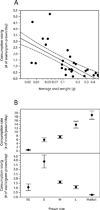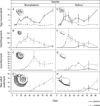Regulation of laboratory populations of snails (Biomphalaria and Bulinus spp.) by river prawns, Macrobrachium spp. (Decapoda, Palaemonidae): implications for control of schistosomiasis
- PMID: 24388955
- PMCID: PMC4280914
- DOI: 10.1016/j.actatropica.2013.12.013
Regulation of laboratory populations of snails (Biomphalaria and Bulinus spp.) by river prawns, Macrobrachium spp. (Decapoda, Palaemonidae): implications for control of schistosomiasis
Abstract
Human schistosomiasis is a common parasitic disease endemic in many tropical and subtropical countries. One barrier to achieving long-term control of this disease has been re-infection of treated patients when they swim, bathe, or wade in surface fresh water infested with snails that harbor and release larval parasites. Because some snail species are obligate intermediate hosts of schistosome parasites, removing snails may reduce parasitic larvae in the water, reducing re-infection risk. Here, we evaluate the potential for snail control by predatory freshwater prawns, Macrobrachium rosenbergii and M. vollenhovenii, native to Asia and Africa, respectively. Both prawn species are high value, protein-rich human food commodities, suggesting their cultivation may be beneficial in resource-poor settings where few other disease control options exist. In a series of predation trials in laboratory aquaria, we found both species to be voracious predators of schistosome-susceptible snails, hatchlings, and eggs, even in the presence of alternative food, with sustained average consumption rates of 12% of their body weight per day. Prawns showed a weak preference for Bulinus truncatus over Biomphalaria glabrata snails. Consumption rates were highly predictable based on the ratio of prawn: snail body mass, suggesting satiation-limited predation. Even the smallest prawns tested (0.5-2g) caused snail recruitment failure, despite high snail fecundity. With the World Health Organization turning attention toward schistosomiasis elimination, native prawn cultivation may be a viable snail control strategy that offers a win-win for public health and economic development.
Keywords: Biological control; Functional response; Predation; Predator; Schistosoma haematobium; Schistosoma mansoni.
Copyright © 2013 Elsevier B.V. All rights reserved.
Figures








References
-
- Adewale IO, Afolayan A. Purification and catalytic properties of glutathione transferase from the Hepatopancreas of crayfish Macrobrachium vollenhovenii (Herklots) Journal of Biochemical and Molecular Toxicology. 2004;18:332–344. - PubMed
-
- Anderson RM, Mercer JG, Wilson RA, Carter NP. Transmission of Schistosoma mansoni from man to snail: experimental studies of miracidial survival and infectivity in relation to larval age water temperature, host size and host age. Parasitology. 1982;85(Pt 2):339–360. - PubMed
-
- Barbaresi S, Gherardi F. The invasion of the alien crayfish Procambarus clarkii in Europe, with particular reference to Italy. Biological Invasions. 2000;2:259–264.
-
- Barbosa FS. Survival in the field of Australorbis glabratus infected with Schistosoma mansoni . J Parasitol. 1963;49:149. - PubMed
-
- Baumgartner L. Fish passage through a Deelder lock on the Murrumbidgee River, Australia. NSW Fisheries Final Report Series. 2003:34.
Publication types
MeSH terms
Substances
Grants and funding
LinkOut - more resources
Full Text Sources
Other Literature Sources
Research Materials
Miscellaneous

